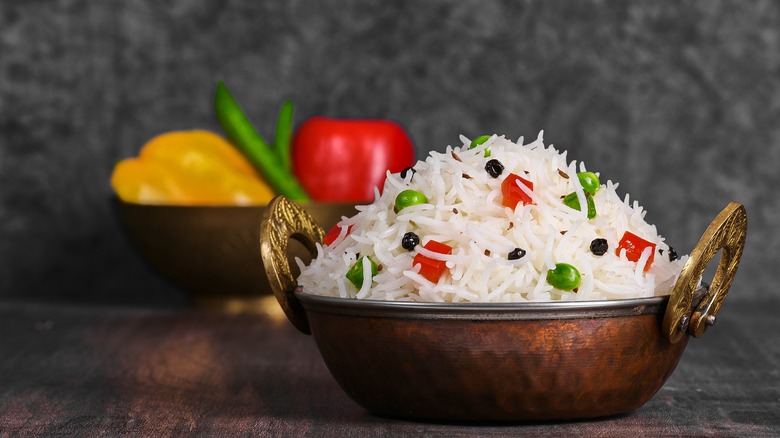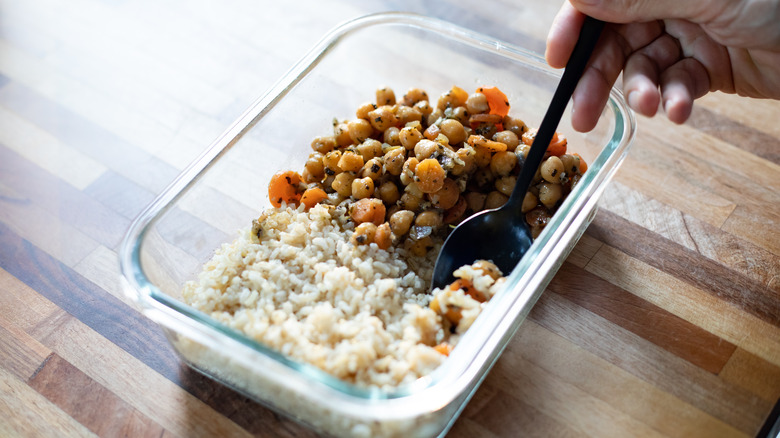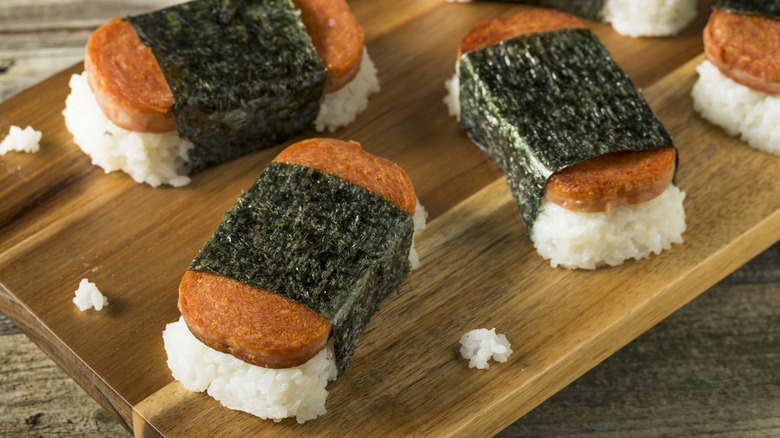The Proper Way To Store And Reheat Leftover Rice
When it comes to food safety and proper techniques to prevent food borne illnesses, many people think of things like raw chicken, mayo-based dishes, and unwashed lettuce. Truthfully, bacteria can grow and thrive on most foods, even the most unassuming of things, like rice. Social media has trended with stories of people getting sick from eating leftover rice, leaving many to wonder if it's even worth saving it at all. In short, yes, you can safely store, reheat, and eat leftover rice so long as you are mindful of how you handle it.
Assuming you've cooked your rice and eaten your fill of it, you'll want to store any leftovers in a covered, airtight container, and place it in the refrigerator immediately. According to recommendations from the USDA, you must do this within two hours of removing your rice from the heat of the stove to prevent dangerous bacterial growth. If you think the rice has been sitting unheated on the counter for longer, it's best to toss away the leftovers. In warm conditions (90 degrees Fahrenheit or more), refrigerate your rice within one hour.
You should eat your leftovers within three to four days, or freeze them for up to four months. When you reheat your rice, whether that's in the microwave or on the stovetop, be sure the food is heated to at least 165 degrees Fahrenheit to destroy any potentially dangerous bacteria.
But what about 'fried rice syndrome'?
In 2023, a TikTok video posted by @jpall20 went viral; it discussed a terrible occurrence in 2008 of a 20-year old Belgian man who died a mere 10 hours after reheating and eating leftover pasta that had been sitting on his kitchen counter for five days. According to a 2011 article from the Journal of Clinical Microbiology, a high amount of the bacteria Bacillus cereus was found in the pasta. Its growth was attributed to improper food storage. Ultimately, the bacteria caused the man's liver to quickly fail.
Bacillus cereus can be found in things like grains and rice because it lives in water and soil, and it can easily be transferred into resources that grow there. While it's a common bacteria whose spores are not killed by heat, it grows to dangerous levels between the temperatures of 40 and 140 degrees Fahrenheit, which is why it's important to quickly store and cool any leftovers. The condition that comes from food poisoning linked to Bacillus cereus has garnered the nickname "fried rice syndrome" even though the bacteria has been linked to foods other than rice, like potatoes, pastries, sushi, and the aforementioned pasta.
Properly stored leftover rice makes great meals
If you've done your due diligence and properly stored your leftover rice in the fridge within the right time frame, there's no shortage of dishes you can create with it. And the best part is: the rice is already done. Despite its somewhat unfair connection to a deadly condition, a classic choice is fried rice. Just toss your rice with a scrambled egg, soy sauce, some veggies, and bite-sized pieces of chicken, and cook everything to 165 degrees Fahrenheit. You can make a great batch of rice pudding with leftover rice as well. All you need to do is heat the rice with milk or cream, some sugar, and whatever else you want to flavor it with, from cocoa powder to dried fruit or a simple vanilla extract.
When you have leftover rice it's the perfect time to make onigiri or musubi, but if you're using SPAM in the recipe, be aware that an open can of the stuff doesn't take long to go bad either. Other ideas include adding your rice to stuffed pepper or zucchini filling, putting it in cabbage rolls and casseroles, and stirring it into soups. You can also combine rice with eggs and flour, form into balls, stuff with cheese, coat with breadcrumbs, and deep fry for an easy and delicious arancini. Enjoy these tasty bites dipped into the best store-bought marinara sauce.


